Toshiba X305-Q725: Quad-Core Gaming Notebook
by Jarred Walton on March 11, 2009 1:00 AM EST- Posted in
- Laptops
Gaming Performance
We've chosen to focus on "reasonable" settings for the games below. That means we run Assassin's Creed and Company of Heroes in DX9 mode at maximum detail setting - DX10 reduces performance by quite a bit in AC and by a much larger amount in CoH. We run Crysis at Medium settings (for reference, High detail drops performance almost in half: 18.3FPS). The remaining games are at maximum detail settings, but without any anti-aliasing. Some titles can certainly handle higher detail settings - Fallout 3 for instance will work fine at up to 1920x1200 0xAA and maximum detail, and the same holds for other games - however, we chose to focus on 1680x1050 performance because of the X305 LCD and because that resolution offers more consistently playable performance on gaming laptops.
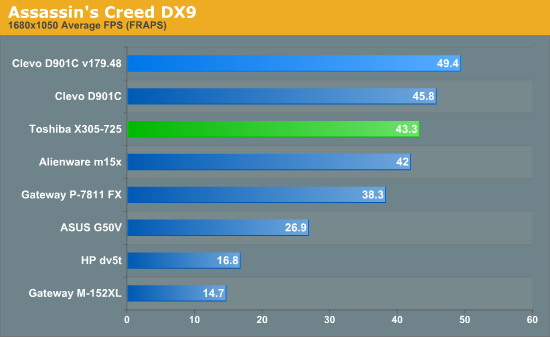
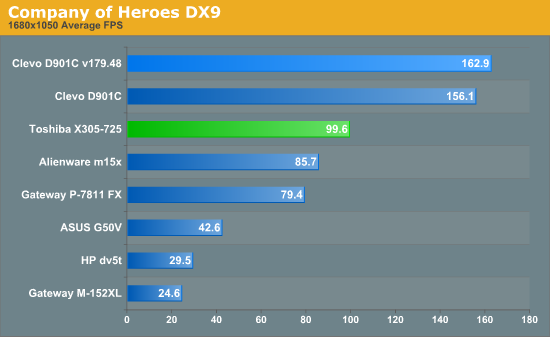
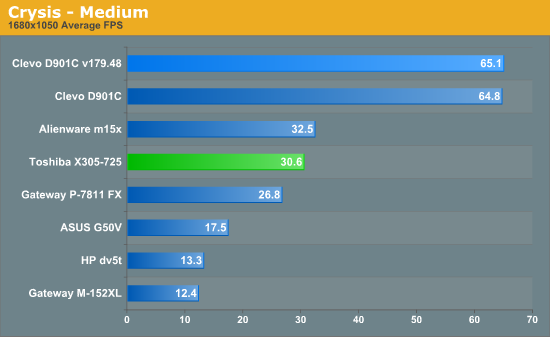
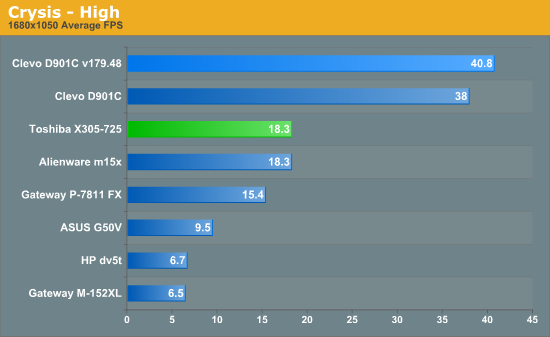
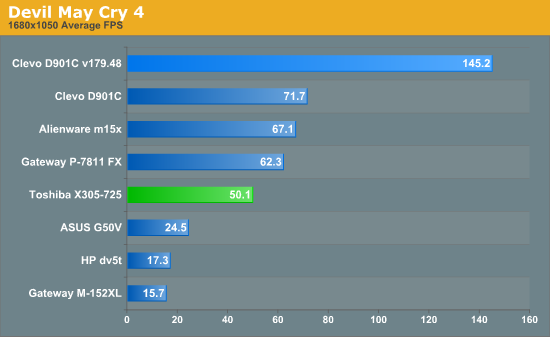
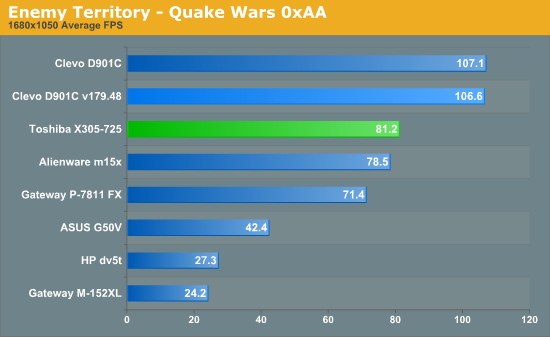
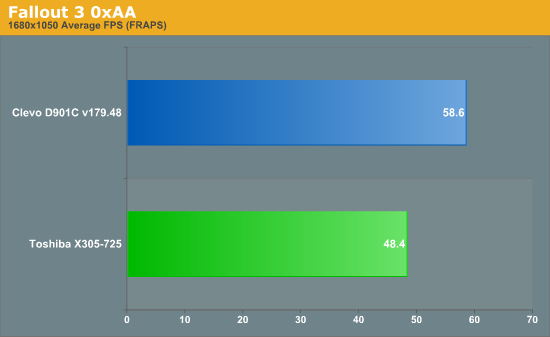
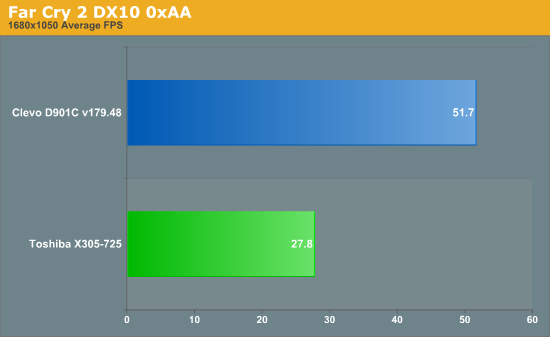
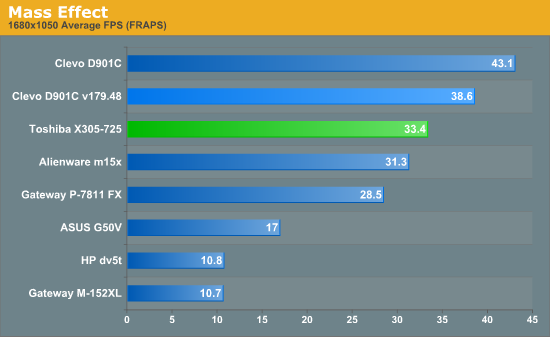
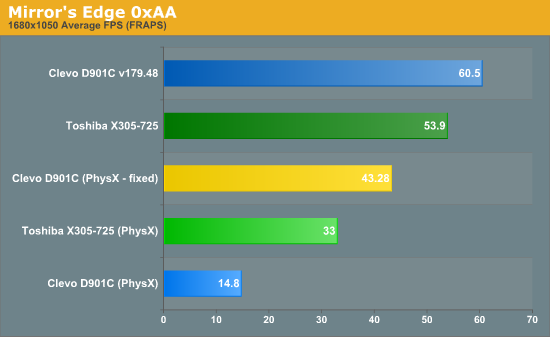
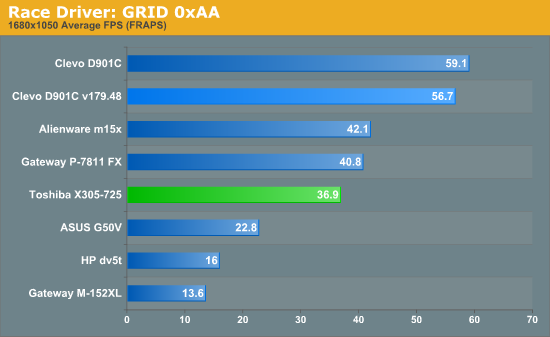
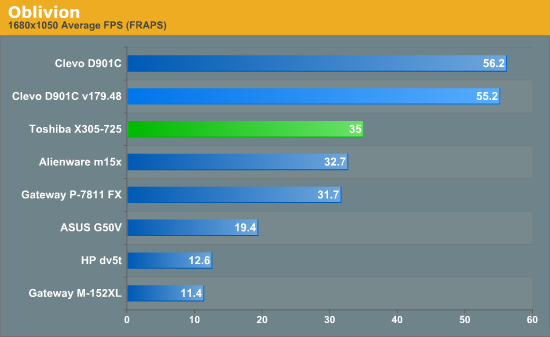
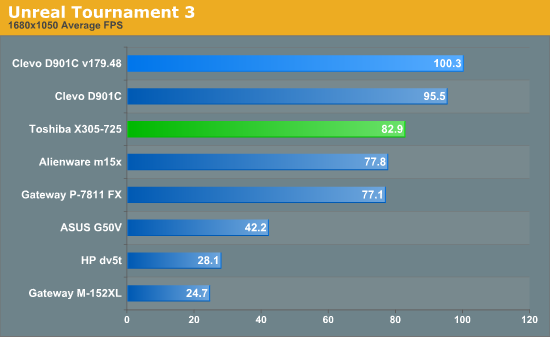
We do run into several situations where the detail settings create system bottlenecks, but overall the SLI 8800M GTX configuration in the Clevo laptop is clearly superior to a single 9800M GTX.
Assassin's Creed likes CPU performance almost as much as GPU power, so the lower clock speed of the Q9000 definitely has an impact here. DX10 performance is acceptable as well and helps to reduce the CPU clock speed penalty, but the overall look of the game isn't substantially changed and performance is still better in all cases under DX9. Enemy Territory: Quake Wars, Fallout 3, Mass Effect, Mirror's Edge, and Unreal Tournament 3 are all in a similar situation. The GPU advantage of the D901C does allow 1920x1200 game play in all of these titles and should increase the margin of victory, but most of these titles are hitting other bottlenecks.
Company of Heroes, Crysis, Devil May Cry 4, Far Cry 2, Oblivion, and GRID all show a greater than 50% performance advantage to the Clevo D901C notebook relative to the X305-Q725. Again, keep in mind that these two notebooks are priced quite similarly, so if you're after raw performance and don't mind a slightly heavier (and perhaps less attractive) chassis the D901C is the clear winner. The dual-core 3.0GHz CPU is a much better choice right now in gaming, though you could install up to a Q9550 if you prefer quad-core processors for non-gaming purposes.
Of all the games we tested, only one title shows any advantage to the 9800M GTX over the 8800M GTX SLI: Mirror's Edge. The advantage is further limited to situations where PhysX support is enabled; otherwise the 8800M SLI is slightly faster. We have not yet confirmed with NVIDIA whether this is a driver bug or is caused by a lack of appropriate hardware on the 8800M GPUs, but we would assume it's a driver issue. The PhysX effects do look nice at times, but even the X305 hits plenty of situations where performance can drop dramatically, and we'd recommend leaving PhysX disabled on these laptop GPUs.
Update: We discussed the Mirror's Edge PhysX issue with NVIDIA and they recommended a manual install of the PhysX drivers just to ensure they were working properly. It looks like the unified graphics/PhysX driver failed to work properly, although the system seemed to think the drivers installed properly. We uninstalled PhysX, rebooted, and installed the drivers again, and that cleared up the performance issue. As you can see, the performance of the D901C is now where you would expect, coming in 33% faster than the X305-Q725.
In the past, we've been hesitant to strongly recommend any laptops with dual GPUs, simply because the drivers were not updated frequently enough to make that a viable solution for long-term gaming pleasure. NVIDIA has now addressed the major stumbling block for SLI in a laptop, so for the mobile gamers we would definitely recommend an SLI notebook over the X305-Q725. In a best case scenario, dual GTX 280M GPUs (with the appropriate CPU) should end up providing around 50% more performance than the 8800M GTX SLI represented by the Clevo D901C, and potentially more than twice the performance of the single 9800M GTX in the X305-Q725.
Before you get too excited about the potential for mobile gaming, we do need to give a few words of caution about relative performance. The GTX 280M may be the fastest current gaming solution for notebooks, but at its core the GTX 280M is nothing more than a mobile version of the GeForce 9800 GTX. The desktop GTX 280/285 (and Radeon HD 4870) are well out of reach of anything a laptop can achieve and should remains so for some time. Short of external cards that connect via ExpressCard adapters, gamers looking for maximum performance will want to play on a desktop, and ExpressCard adapters are hardly a panacea - is anyone really going to get a laptop only to add a secondary device that requires a separate power source? I can't say the prospect is very appealing to me at any rate.










32 Comments
View All Comments
yyrkoon - Thursday, March 12, 2009 - link
I agree with the SFF notion except for a few points.The first point would be that no reputable mini-ITX motherboard manufacturer sells a motherboard with 16x PCI-e. Sure, you could always *attempt* to play games with the onboard graphics, but you're most likely going to be very disappointed.
Second point would be power usage if that is a concern ( which for me it can be since we're solar/wind power ). a SFF system built with care, and plenty of thought can still be a power house ( subjective ), and use ~50W without a beefy graphics card. However, you will find it very hard to beat a laptop in power usage just because of the LCD you have to hook up to that SFF system. A typical 19" WS LCD such as the one I have will use 23W all by its self which can put a damper on this aspect of the idea.
Another point would be cutting edge technology on SFF mini-ITX boards. I have yet to find a mini-ITX board of current that will address more than 4GB of RAM, a lot of them only have two DIMM slots. Let us not forget that a lot of graphics editors could use such a system ( I am one ), and even 4GB of RAM is cutting it close if you want to do any *real* image manipulation. The of course you have outdated chipsets on a lot of these boards that make them not even worth purchasing in my own personal opinion.
Anyhow, I suppose if you did not mind using a mATX board, you may be able to come out ahead on some of all of these issues ( plus many more I did not even address ). But if you're looking for a mini-ITX board that either uses laptop or desktop based CPU's . . . well, I just think that we're al going to be SOL for a long time to come yet.
cheetah2k - Thursday, March 12, 2009 - link
Definately a white elephant. Not only that, wheres the subjective review vs a comparitive Dell XPS 1730?